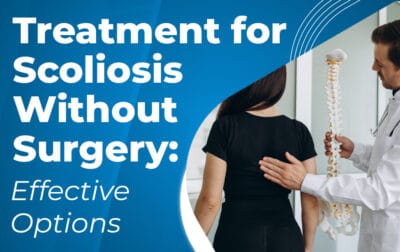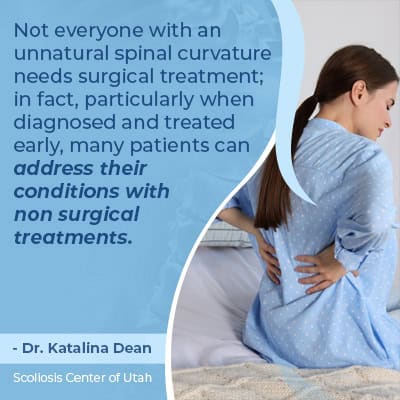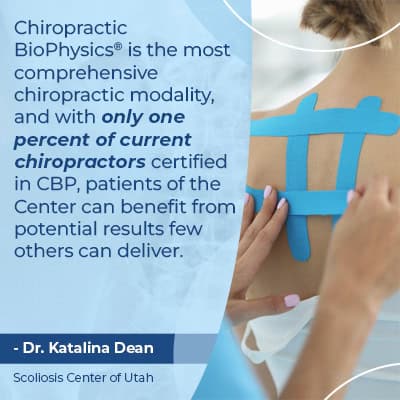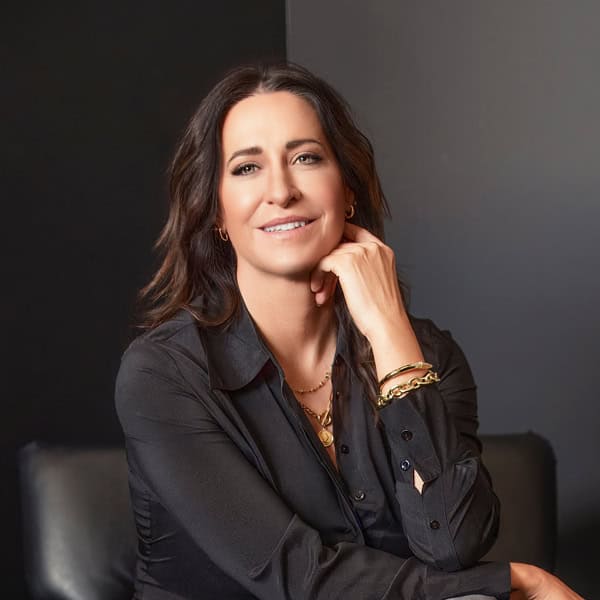Blogs
Treatment for Scoliosis Without Surgery: Effective Options

Not everyone with an unnatural spinal curvature needs surgical treatment; in fact, particularly when diagnosed and treated early, many patients can address their conditions with non surgical treatments. Conservative treatments are evidence-based, innovative, and integrative; continue reading to learn more.
Through a combination of Chiropractic Biophysics®, the ScoliBalance® program, and the ScoliBrace® system, scoliosis can be addressed with non surgical treatment; there is potential to realign the spine, improve posture, and strengthen the spine’s surrounding muscles.
To better understand the benefits of nonsurgical treatment options for scoliosis, let’s start with what happens to the spine and body as scoliosis develops and progresses.
Understanding Scoliosis
What exactly is scoliosis? While most people have heard of scoliosis and have a basic awareness that it involves the spine, many don’t realize just how common a condition it is.
Scoliosis is the main spinal condition affecting school-aged children, and there are close to seven million people currently diagnosed with scoliosis in the United States alone; remember, these numbers are only based on known cases; it’s not uncommon for people to be unaware they have scoliosis.
 Scoliosis treatment is always beneficial because as a progressive condition, most cases of scoliosis are going to get worse.
Scoliosis treatment is always beneficial because as a progressive condition, most cases of scoliosis are going to get worse.
Scoliosis causes the spine to develop an unnatural lateral curvature (bends to the side) that also rotates or twists, and scoliosis progression means the unhealthy curvature of the spine is getting larger, and its effects are going to become more noticeable.
The key to successfully treating scoliosis without surgery is early detection and intervention; although there are never treatment guarantees, cases that are diagnosed while still mild and have proactive treatment applied immediately following a diagnosis are more likely to respond well.
Let’s now address the specific benefits associated with early detection and intervention.
Early Detection Benefits
The most significant potential benefit of diagnosing scoliosis early is that it means treatment can be started early, and when successful, this can also mean preventing progression and the need for invasive future surgical treatment.
Early detection means that scoliosis is diagnosed before significant progression has occurred; the rate of scoliosis progression can range from glacial to rapid, and the age group most at risk for rapid progression are adolescents because they are experiencing the rapid and unpredictable growth that occurs during puberty.
Adolescent idiopathic scoliosis is the most prevalent type of scoliosis overall, and as it’s growth that triggers the progression of scoliosis, children are the most at risk for fast progression.
The more scoliosis progresses, the more difficult it can be to treat; as the size of the unnatural spinal curve increases, it makes the spine more rigid and less responsive to treatment.
In addition, the more scoliosis progresses, the more pronounced its effects are, and in children, the most noticeable effect of scoliosis involves postural changes, and in adults, the main symptom that leads to a diagnosis is pain.
So the main benefit of early detection is that it can lead to early intervention, but that depends on the chosen treatment approach; there are clear benefits associated with non surgical treatment options.
The Benefits of Non Surgical Scoliosis Treatment
There are a number of benefits associated with treating scoliosis without surgery, and two of the primary reasons involve progression and long-term spinal health.
When it comes to a proactive treatment approach, this involves a focus on working towards preventing progression by starting treatment when conditions are at their mildest and most likely to respond well.
Although progressive, scoliosis can be highly manageable and treatable, and the milder scoliosis is when treatment is started, the fewer limits there are to non surgical scoliosis treatment.
Proactive non surgical treatment can help prevent progression, and when it comes to spinal health, a scoliotic spine that’s corrected with non surgical treatment is one that’s likely to be stronger, more flexible, and better able to handle stress.
For young athletic patients, maintaining a wide range of spinal flexibility and range of motion should be a priority because a noticeable loss, that’s common with scoliosis surgery, can affect a patient’s overall quality of life.
So some of the main benefits of non surgical scoliosis treatment is that it can help prevent progression, increasing condition effects, and the need for future surgical treatment.
Now that we’ve explored why non surgical treatment is beneficial, let’s discuss the different treatment modalities applied.
Non Surgical Scoliosis Treatment Options
Conservative treatments are integrative; they work together to complement one another and impact conditions on every level for long-term sustainable results.
Here at the Scoliosis Center of Utah, the treatment focus is on postural and curvature correction through the application of Chiropractic BioPhysics®, the ScoliBrace® system, and our ScoliBalance physical therapy; all three work together to address the whole structure, muscles, discs, ligaments and spine.
When it comes to structural conditions like scoliosis, a structural abnormality within the spine itself is the underlying cause, so to be treated effectively, a scoliotic spine has to be impacted on a structural level, and this involves reducing the size of the unnatural spinal curvature.
Chiropractic Care
Chiropractic BioPhysics® is the most comprehensive chiropractic modality, and with only one percent of current chiropractors certified in CBP, patients of the Center can benefit from potential results few others can deliver.
 Chiropractic adjustments alone treat the symptoms, while Chiropractic BioPhysics® address the cause of the problem and bring balance and harmony back to the body.
Chiropractic adjustments alone treat the symptoms, while Chiropractic BioPhysics® address the cause of the problem and bring balance and harmony back to the body.
CBP employs physiology, physics, anatomy, geometry and biology to identify the underlying causes of pain, spinal misalignment, mobility issues, and neurological symptoms.
Remember, as the spine and brain form the central nervous system, spinal conditions can disrupt posture, movement, and sensation.
The spine contains 31 pairs of spinal nerves, and an unnaturally-curved spine can cause any of those nerves to become impinged, compressed, and irritated.
At its simplest, CBP combines the power of chiropractic care and scientific principles to diagnose, assess, and treat a number of issues related to spinal health.
ScoliBalance®
ScoliBalance® is our Physical Therapy program, using exercises specific to your scoliosis curve.
As a 3-dimensional disease, scoliosis needs to be addressed with 3-dimensional exercises. Basic core exercise given to you by your physical therapist or your trainer will not work for Scoliosis patients.
Scoliosis spine has a bend and a twist in the spine and specific exercise will be given to unbend and untwist your spine, bringing your spine back to alignment.
The power of using scoliosis-specific exercises is key to non surgical scoliosis treatment as it’s not just the spine that maintains its proper alignment, but also the spine’s surrounding muscles that have to support and stabilize the spine.
If CBP is successful at realigning the spine, the structural changes need to be supported, and this is why muscle imbalances need to be addressed and strengthening exercises are applied in our ScoliBalance program for a stronger core.
SEAS (Scientific Exercise Approach to Scoliosis) and Schroth method therapy focus on the corrective power of scoliosis-specific exercises (SSEs), commonly using mirror image exercises to help with postural awareness and remodeling; we have taken the very best of each of these methods and combined them into our ScoliBalance® Program.
So now that we’ve addressed the benefits of non surgical treatment, let’s talk about the potential negatives associated with spinal fusion surgery.
Surgical Scoliosis Treatment
While spinal fusion surgery can still have a place in the treatment of atypical and very severe cases of scoliosis, many spinal conditions can be addressed with non surgical treatment that’s less invasive and better for the spine’s long-term spinal health and function.
When it comes to restoring spinal alignment with surgery, this commonly involves spinal fusion: fusing multiple vertebrae into one solid bone so they can’t shift further out of alignment with the rest of the spine, and securing the spine’s aligned position with metal rods that are permanently attached.
Daily life can be affected by a fused spine that’s weaker so is going to be more vulnerable to injury, is likely to be less flexible with a reduced range of motion, and results can never be guaranteed.
Spinal fusion is typically recommended for curves that are classified as severe at 50+ degrees, but the traditional treatment approach that spinal fusion is associated with doesn’t have a strategy for addressing scoliosis while mild, which means doing little to nothing to prevent progression.
Early intervention is always best; however, in cases of adult scoliosis left untreated, the spine will start to collapse on itself, degenerate. A degenerative scoliosis is very painful.
Traditional surgical treatment is more reactive than proactive as it commonly responds with a surgical recommendation when/if conditions progress into the severe classification, but prior to that, only observation and traditional bracing are applied.
Many times, surgery is not possible for a degenerative spine. At the Scoliosis Center of Utah, we offer a custom ScoliBrace® and ScoliBalance® physical therapy to relieve pain, improve quality of life, and prevent the spine from further degeneration.
Conclusion
The most important decision a scoliosis patient has to make is whether to commit to a traditional or conservative treatment approach.
The way a diagnosis of scoliosis is responded to with treatment will shape the spine’s long-term function, and while there can be a significant time period needed to fully recover from surgical treatment, scoliosis cases addressed with conservative treatment don’t require a specific recovery period.
Through a combination of Chiropractic BioPhysics®, the ScoliBrace® system, and the ScoliBalance® physical therapy program, most patients benefit from improving posture, spinal alignment, and reducing curve size and pain.
All types and severity levels of scoliosis require treatment, and the best way to prevent scoliosis progression is customizing and applying a proactive treatment plan.
Not every scoliosis diagnosis means the patient will require surgery; a scoliosis curve can be highly responsive to scoliosis-specific chiropractic care and physical therapy.
Patient education is important because knowing the signs of scoliosis can lead to early detection, and knowing how to lead a scoliosis-friendly lifestyle once diagnosed can be important for a healthy life in general.
So don’t hesitate to reach out to Dr. Dean for guidance, support, and an innovative evidence-based approach to non surgical scoliosis treatment.

Dr. Katalina Dean
Dr. Katalina Dean is the founder and clinical director of Scoliosis Center of Utah, in Midvale, UT. Her team specializes in posture correction, spinal rehabilitation, and non-invasive scoliosis care and bracing.
Call Today
Do You Qualify for Care?
Schedule an Appointment Below
